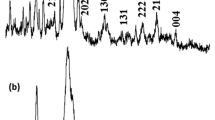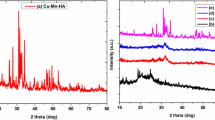Abstract
In this study, in situ synthesis of polyvinyl alcohol (PVA)/nano-hydroxyapatite (n-HA)/cellulose nanocrystals (CNC) organic–inorganic biocomposite porous scaffolds is reported. The effect of the CNC content on the properties of the biocomposite scaffold was investigated and characterized using field-emission scanning electron microscopy, Fourier-transform infrared spectroscopy (FTIR), X-ray diffraction (XRD) analysis, porosity and compressive strength measurements, thermal studies, and in vitro biomineralization and degradation studies. The morphological study showed highly porous structures with good pore interconnectivity in which n-HA was homogeneously dispersed. XRD analysis showed a decrease in the crystalline fraction and crystallite size of nano-hydroxyapatite with introduction of PVA and with increasing content of CNC. It was observed that the porosity decreased to some extent with increasing CNC content, while increases in the compressive strength (from 0.85 to 2.09 MPa) and elastic modulus (from 4.68 to 16.01 MPa) were found as the CNC content was increased. In vitro biomineralization study revealed the formation of apatite on PVA/n-HA/CNC biocomposite scaffolds when soaked for 7 and 14 days in simulated body fluid (SBF) solution. The obtained porous scaffolds offering good mechanical performance may provide a promising alternative scaffolding matrix for use in the field of bone tissue engineering.











Similar content being viewed by others
Abbreviations
- AFM:
-
Atomic force microscopy
- CNC:
-
Cellulose nanocrystals
- CPC:
-
Chemically purified cellulose
- EDX:
-
Energy-dispersive X-ray diffraction
- FE-SEM:
-
Field-emission scanning electron microscopy
- FTIR:
-
Fourier-transform infrared
- n-HA:
-
Nano-hydroxyapatite
- PBS:
-
Phosphate buffered saline
- PVA:
-
Polyvinyl alcohol
- SBF:
-
Simulated body fluid
- SCB:
-
Sugarcane bagasse
- TGA:
-
Thermogravimetric analysis
- XRD:
-
X-ray diffraction
References
Asran AS, Henning S, Michler GH (2010) Polyvinyl alcohol–collagen–hydroxyapatite biocomposite nanofibrous scaffold: mimicking the key features of natural bone at the nanoscale level. Polymer 51:868–876
Assender HE, Windle AH (1998) Crystallinity in poly(vinyl alcohol). 1. An X-ray diffraction study of atactic PVOH. Polymer 39:4295–4302
Avella M, Cocca M, Errico ME, Gentile G (2012) Polyvinyl alcohol biodegradable foams containing cellulose fibres. J Cell Plast 48:459–470
Bai YP, Yang RJ, Li JM (2002) Synthesis and swelling characteristic of interpenetrating polymer network hydrogel composed of poly(vinyl alcohol) and poly(acrylic acid). Polym Mater Sci Eng 18:98–101
Cai X, Tong H, Shen X, Chen W, Yan J, Hu J (2009) Preparation and characterization of homogeneous chitosan-polylactic acid/hydroxyapatite nanocomposite for bone tissue engineering and evaluation of its mechanical properties. Acta Biomater 5:2693–2703
Chang MC, Ko CC, Douglas WH (2003) Preparation of hydroxyapatite–gelatin nanocomposite. Biomaterials 24:2853–2862
Chang C, Peng N, He M, Teramoto Y, Nishio Y, Zhang L (2013) Fabrication and properties of chitin/hydroxyapatite hybrid hydrogels as scaffold nano-materials. Carbohydr Polym 91:7–13
Chen W, Yu H, Liu Y, Chen P, Zhang M, Hai Y (2011) Individualization of cellulose nanofibres from wood using high-intensity ultrasonication combined with chemical pre-treatments. Carbohydr Polym 83:1804–1811
Costa-Junior ES, Barbosa-Stancioli EF, Mansur AAP, Vasconcelos WL, Mansur HS (2009) Preparation and characterization of chitosan/poly(vinyl alcohol) cross-linked blends for biomedical applications. Carbohydr Polym 76:472–481
da Gomes GS, de Almeida AT, Kosaka PM, Rogero SO, Cruz AS, Ikeda TI, Petri DFS (2007) Cellulose acetate propionate coated titanium: characterization and biotechnological application. Mater Res 10:469–474
Degirmenbasi N, Kalyon DM, Birinci E (2006) Biocomposites of nanohydroxyapatite with collagen and poly(vinyl alcohol). Colloids Surf B 48:42–49
Deville E, Saiz E, Nalla RK, Tomsia AP (2006) Freezing as a path to build complex composites. Science 311:515–518
Dorozhkin SV, Epple M (2002) Biological and medical significance of calcium phosphates. Angew Chem Int Ed 41:3130–3146
Dugan JM, Gough JE, Eichhorn SJ (2010) Directing the morphology and differentiation of skeletal muscle cells using oriented cellulose nanowhiskers. Biomacromolecules 11:2498–2504
Entcheva E, Bien H, Yin LH, Chung CY, Farrell M, Kostov Y (2004) Functional cardiac cell constructs on cellulose-based scaffolding. Biomaterials 25:5753–5762
Fenglan X, Yubao L, Xuejiang W (2004) Preparation and characterization of nano-hydroxyapatite/poly(vinyl alcohol) hydrogel biocomposite. J Mater Sci 39:5669–5672
Ficai M, Andronescu E, Ficai D, Voicu G, Ficai A (2010) Synthesis and characterization of COLL–PVA/HA hybrid materials with stratified morphology. Colloids Surf B 81:614–619
Fujii S, Okada M, Sawa H, Furuzono T, Nakamura Y (2009) Hydroxyapatite nanoparticles as particulate emulsifier: fabrication of hydroxyapatite-coated biodegradable microspheres. Langmuir 25:9759–9766
Garside P, Wyeth P (2003) Identification of cellulosic fibres by FTIR spectroscopy: thread and single fibre analysis by attenuated total reflectance. Stud Conserv 48:269–275
George J, Ramana KV, Bawa AS (2011) Bacterial cellulose nanocrystals exhibiting high thermal stability and their polymer nanocomposites. Int J Biol Macromol 48:50–57
Gibson LJ (2005) Biomechanics of cellular solids. J Biomech 38:377–399
Grande CJ, Torres FG, Gomez CM, Bano MC (2009) Nanocomposites of bacterial cellulose/hydroxyapatite for biomedical applications. Acta Biomater 5:1605–1615
Gu ZO, Xiao JM, Zhang XH (1998) The development of artificial articular cartilage PVA-hydrogel. Biomed Mater Eng 8:75–81
Guirguis OW, Moselhey MT (2012) Thermal and structural studies of poly(vinyl alcohol) and hydroxypropyl cellulose blends. Nat Sci 4:57–67
Gutiérrez MC, García-Carvajal ZY, Jobbágy M, Rubio F, Yuste L, Rojo F, Ferrer ML, del Monte F (2007) Poly (vinyl alcohol) scaffolds with tailored morphologies for drug delivery and controlled release. Adv Funct Mater 17:3505–3513
Hoepfner S, Ratke L, Milow B (2008) Synthesis and characterization of nanofibrillar cellulose aerogels. Cellulose 15:121–129
Hortigüela MJ, Gutiérrez MC, Aranaz I, Jobbágy M, Abarrategi A, Moreno-Vicente C, Civantos A, Ramos V, Lopez-Lacomba JL, Ferrer ML, del Monte F (2008) Urea assisted hydroxyapatite mineralization on MWCNT/CHI scaffolds. J Mater Chem 18:5933–5940
Hubbe MA, Rojas OJ, Lucia LA, Sain M (2008) Cellulosic nanocomposites: a review. BioResources 3:929–980
Katti KS, Katti DR, Dash R (2008) Synthesis and characterization of a novel chitosan/montmorillonite/hydroxyapatite nanocomposite for bone tissue engineering. Biomed Mater 3:034122
Kim UJ, Park J, Kim HJ, Wada M, Kaplan DL (2005) Three-dimensional aqueous-derived biomaterial scaffolds from silk fibroin. Biomaterials 26:2775–2785
Kokubo T, Takadama H (2006) How useful is SBF in predicting in vivo bone activity? Biomaterials 27:2907–2915
Kumar A, Negi YS, Bhardwaj NK, Choudhary V (2012) Synthesis and characterization of methylcellulose/PVA based porous composite. Carbohydr Polym 88:1364–1372
Kumar K, Negi YS, Bhardwaj NK, Choudhary V (2013) Synthesis and characterization of cellulose nanocrystals/PVA based bionanocomposite. Adv Mater Lett 4:626–631
Kumar A, Negi YS, Choudhary V, Bhardwaj NK (2014a) Effect of modified cellulose nanocrystals on microstructural and mechanical properties of polyvinyl alcohol/ovalbumin biocomposite scaffolds. Mater Lett 129:61–64
Kumar A, Negi YS, Choudhary V, Bhardwaj NK (2014b) Characterization of cellulose nanocrystals produced by acid hydrolysis from sugarcane bagasse as agro-waste. J Mater Phys Chem 2:1–8
Lee C, Grodzinsky A, Hsu HP, Spector M (2003) Effects of a cultured autologous chondrocyte-seeded type II collagen scaffold on the healing of a chondral defect in a canine model. J Orthop Res 21:272–281
Lee SB, Kim YH, Chong MS, Hong SH, Lee YM (2005) Study of gelatin-containing artificial skin V: fabrication of gelatin scaffolds using a salt-leaching method. Biomaterials 26:1961–1968
Liu YK, Houm DD, Wang GH (2004) A simple wet chemical synthesis and characterization of hydroxyapatite nanorods. Mater Chem Phys 86:69–73
Liu H, Liu D, Yao F, Wu Q (2010) Fabrication and properties of transparent polymethylmethacrylate/cellulose nanocrystals composites. Bioresour Technol 101:5685–5692
Mandal A, Chakrabarty D (2011) Isolation of nanocellulose from waste sugarcane bagasse (SCB) and its characterization. Carbohydr Polym 86:1291–1299
Mathew AP, Oksman K, Pierron D, Harmand M-F (2012) Fibrous cellulose nanocomposite scaffolds prepared by partial dissolution for potential use as ligament or tendon substitutes. Carbohydr Polym 87:2291–2298
Nie L, Chen D, Suo J, Zou P, Feng S, Yang Q, Yang S, Ye S (2012) Physicochemical characterization and biocompatibility in vitro of biphasic calcium phosphate/polyvinyl alcohol scaffolds prepared by freeze-drying method for bone tissue engineering applications. Colloids Surf B 100:169–176
Pan Y (2010) Swelling properties of nano-hydroxyapatite reinforced poly(vinyl alcohol) gel biocomposites. Micro Nano Lett 5:237–240
Pooyan P, Tannenbaum R, Garmestani H (2012) Mechanical behavior of a cellulose-reinforced scaffold in vascular tissue engineering. J Mech Behav Biomed Mater 7:50–59
Pooyan P, Kim IT, Jacob KI, Tannenbaum R, Garmestani H (2013) Design of a cellulose-based nanocomposite as a potential polymeric scaffold in tissue engineering. Polymer 54:2105–2114
Poursamar SA, Rabiee M, Samadikuchaksaraei A, Tahriri M, Karimi M, Azami M (2009) Influence of the value of pH on the preparation of nano-hydroxyapatite–polyvinyl alcohol composites. J Ceram Process Res 10:679–682
Rezwan K, Chen QZ, Blaker JJ, Boccaccini AR (2006) Biodegradable and bioactive porous polymer/inorganic composite scaffolds for bone tissue engineering. Biomaterials 27:3413–3431
Roman M, Winter WT (2004) Effect of sulfate groups from sulfuric acid hydrolysis on the thermal degradation behavior of bacterial cellulose. Biomacromolecules 5:1671–1677
Rosenau T, Liebner F, Potthast A, Haimer E, Wendland M (2007) Ultralightweight cellulose aerogels from NBnMO-stabilized lyocell dopes. Res Lett Mater Sci 2007:1–4
Rusu VM, Ng CH, Wilke M, Tiersch B, Fratzl P, Peter MG (2005) Size-controlled hydroxyapatite nanoparticles as self-organized organic–inorganic composite materials. Biomaterials 26:5414–5426
Sahai N, Tossell JA (2000) Molecular orbital study of apatite (Ca5(PO4)3OH) nucleation at silica bioceramic surfaces. J Phys Chem B 104:4322–4341
Samir M, Alloin F, Dufresne A (2005) Review of recent research into cellulosic whiskers, their properties and their application in nanocomposite field. Biomacromolecules 6:612–626
Sang JL, Grace JL, Lee JW, Anthony A, James JY (2006) In-vitro evaluation of a poly(lactide-co-glycolide)–collagen composite scaffold for bone regeneration. Biomaterials 27:3466–3472
Stevens MM, George JH (2005) Cellulose acetate propionate coated titanium: characterization and biotechnological application. Science 310:1135–1138
Tolba E, Abd-Elhady BM, Elkholy B, Elkady H, Eltonsi M (2010) Biomimetic synthesis of guided-tissue regeneration hydroxyapatite/polyvinyl alcohol nanocomposite scaffolds: influence of alginate on mechanical and biological properties. J Am Sci 6:239–249
Troedec M, Sedan D, Peyratout C, Bonnet J, Smith A, Guinebretiere R, Gloaguen V, Krausz P (2008) Influence of various chemical treatments on the composition and structure of hemp fibers. Compos Part A Appl S 39:514–522
Uddin AJ, Araki J, Gotoh Y (2011) Towards “strong” green nanocomposites: polyvinyl alcohol reinforced with extremely oriented cellulose whiskers. Biomacromolecules 12:617–624
Wan YZ, Hong L, Jia SR, Huang Y, Zhu Y, Wang YL, Jiang HJ (2006) Synthesis and characterization of hydroxyapatite–bacterial cellulose nanocomposites. Compos Sci Technol 66:1825–1832
Wang M, Chen LJ, Ni J, Weng J, Yue CY (2001) Manufacture and evaluation of bioactive and biodegradable materials and scaffolds for tissue engineering. J Mater Sci Mater Med 12:855–860
Xinhong C, Dairong C, Xiuling J (2008) Chitosan-based aerogels with high adsorption performance. J Phys Chem B 112:7721–7725
Xu CY, Inai R, Kotaki M, Ramakrishna S (2004) Aligned biodegradable nanofibrous structure: a potential scaffold for blood vessel engineering. Biomaterials 25:877–886
Zhang X, Li Y, Lv G, Zuo Y, Mu Y (2006) Thermal and crystallization studies of nano-hydroxyapatite reinforced polyamide 66 biocomposites. Polym Degrad Stab 91:1202–1207
Zhang CY, Lu H, Zhuang Z, Wang XP (2010) Nano-hydroxyapatite/poly(lactic acid) composite synthesized by a modified in situ precipitation: preparation and properties. J Mater Sci Mater Med 21:3077–3083
Zhang F, He C, Cao L, Feng W, Wang H, Mo X, Wang J (2011) Fabrication of gelatin–hyaluronic acid hybrid scaffolds with tunable porous structures for soft tissue engineering. Int J Biol Macromol 48:474–481
Zhou H, Lee J (2011) Nanoscale hydroxyapatite particles for bone tissue engineering. Acta Biomater 7:2769–2781
Acknowledgments
The authors are grateful to the Ministry of Human Resource Development (MHRD), New Delhi for providing financial support to A.K. The authors would also like to acknowledge Dr. Bhupender Singh Butola (Department of Textile Technology, Indian Institute of Technology Delhi) for providing access to the freeze-drying unit (Metrex Scientific Instruments Pvt. Ltd.) and the Indian Institute of Technology Roorkee (IIT Roorkee) for various other infrastructures required for advanced research work in the field of biocomposites.
Author information
Authors and Affiliations
Corresponding author
Rights and permissions
About this article
Cite this article
Kumar, A., Negi, Y.S., Choudhary, V. et al. Microstructural and mechanical properties of porous biocomposite scaffolds based on polyvinyl alcohol, nano-hydroxyapatite and cellulose nanocrystals. Cellulose 21, 3409–3426 (2014). https://doi.org/10.1007/s10570-014-0339-7
Received:
Accepted:
Published:
Issue Date:
DOI: https://doi.org/10.1007/s10570-014-0339-7




